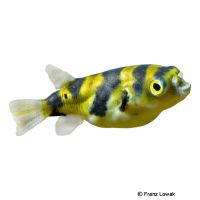Banded Puffer (Colomesus psittacus)
| Banded Puffer Colomesus psittacus | |
|---|---|
| Name | Banded Puffer |
| Name Lat. | Colomesus psittacus |
| Family | Puffers |
| Family lat. | Tetraodontidae |
| Order | Puffers & Filefishes |
| Order lat. | Tetraodontiformes |
| Origin | Brazil |
| Habitat | Estuaries, mangrove swamps |
| Diet | Carnivore |
| pH | 6.8-8.5 |
| Behavior | Semi-aggressive |
| Keeping | Individual, group |
| Care Level | Difficult |
| Reproduction | Egg scatterer |
| Breeding | None reported |
| Life Span | 8-10 years |
| Protection | No |
| Metric Units | |
| Size | 15 cm |
| Temperature | 22-28 °C |
| Hardness | 7-20 °dH |
| Aquarium | ~ 350 l |
| US Units | |
| Size | 6" |
| Temperature | 72-82 °F |
| Hardness | 125-356 ppm |
| Aquarium | ~ 90 gal |
Distribution and habitat
Parrot pufferfishes are common in the nearshore waters of northeastern South America, from the Gulf of Paria to northern Brazil. There they live in mangrove streams and marshes and in the intertidal zone of estuaries, where they usually stay in shallow water in shady places with dense, overhanging riparian vegetation. Only occasionally do they venture into freshwater areas.
Maintenance
The aquarium should have a dense border and background planting, with many hiding places (stones, roots) and provide sufficient swimming space. A dark, fine sandy substrate covered with some foliage (e.g. sea almond leaves), some shaded light (floating plants) and brackish water with a weak current is ideal.
No ammonia, ammonium and nitrite should be detectable, the nitrate value should not exceed 100 mg/l. To ensure the water quality and oxygen content, a filter and heater adapted to the aquarium size is required, as well as lighting for the species-appropriate day-night rhythm of the animals.
Diet
They are food specialists that eat almost exclusively crustaceans. The food supply consists of snails (e.g. bubble snails, or apple snails) supplemented with live or frozen food, such as shrimp, mosquito larvae, artemia, mysis, etc., as well as mussel and crab meat or a frozen special food mixture. Rarely flake or granulated food is accepted
It is recommended to feed small portions several times a day, which are eaten within a few minutes. A regular and varied diet promotes health and increases resistance.
Behaviour and compatibility
It is recommended to keep these relatively peaceful puffer fish individually or in a group of 3-4. For group keeping, a larger, richly structured tank is recommended. They are considered fin twitchers and should not be kept with long-finned fish
Generally, only compatible fish species with similar water condition and water temperature requirements should be socialized.
Sex dimorphism
The sexes are difficult to distinguish. The males remain slightly smaller than the more plump females.
Reproduction and breeding
There are no known reports of successful breeding in the aquarium.
Important
Permanent keeping of parrot pufferfish is possible only in brackish water (5-30 ‰ salinity).
They need the hard shells of snails, or the shells of shrimps, crabs and crayfish to wear their teeth, which are constantly growing back. Teeth that are too long make feeding impossible and they would starve to death.
The parrot pufferfishes are very similar to the isopod pufferfishes (Colomesus asellus). The isopod puffers, which are found exclusively in freshwater, have only 5 setae (body spots) unlike the parrot puffers which have 6 setae.
Pufferfish can inflate to twice their size by filling their expandable stomach with air or water
A cup filled with aquarium water, not a catch net, should be used for transferring or transferring puffers to prevent them from becoming airborne.
The well-being of the fish should be checked regularly. Temperature should be checked daily, pH, hardness and nitrate levels at least every 14 days. Regular partial water changes are recommended, even if the pollutant level has not yet reached the upper limit. Sudden changes in water quality should be avoided. Newly introduced fish must be accustomed slowly to the water in the aquarium.
Further literature can be found in your pet store.
References
Text: petdata; Image: Franz Lowak
Source: BMEL (1998): Tierschutzgutachten - Haltung von Zierfischen (Süßwasser); BAENSCH & RIEHL (2004): Aquarien Atlas Bd. 2, Mergus Verlag; ENGELMANN (2005): Zootierhaltung - Tiere in menschlicher Obhut: Fische, Verlag Harri Deutsch
- Gemäß § 21 Abs. 5 Tierschutzgesetz idgF
